8 Arthurian Myths and Legends: The Search for the Holy Grail, King Arthur, Queen Guinevere, Sir Lancelot, and The Lady of Shalott
Selected Images from Arthurian Legends: The Search for the Holy Grail, King Arthur, Queen Guinevere, Sir Lancelot, the Lady of the Lake, and the Lady of Shalott
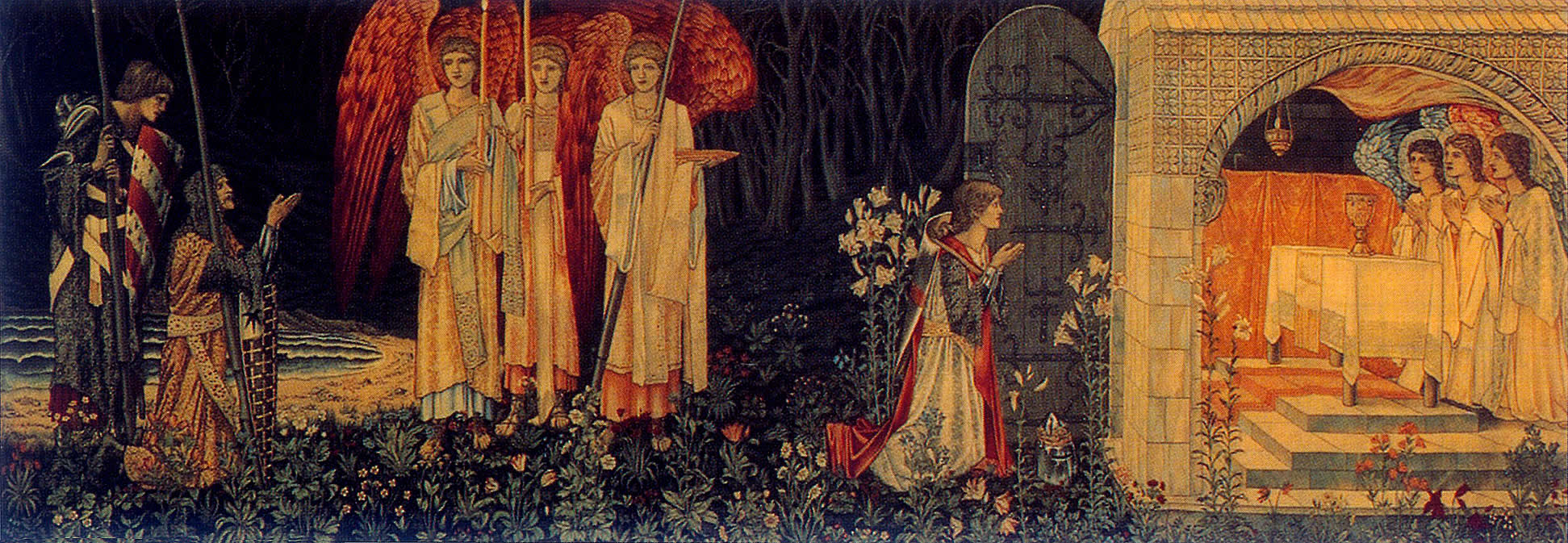
Courtesy: By Sir Edward Burne-Jones, overall design and figures; William Morris, overall design and execution; John Henry Dearle, flowers and decorative details. – Unknown source, Public Domain, https://commons.wikimedia.org/w/index.php?curid=251121
Note: The Attainment: The Vision of the Holy Grail to Sir Galahad, Sir Bors, and Sir Perceval (also known as The Achievement of the Grail or The Achievement of Sir Galahad, accompanied by Sir Bors, and Sir Perceval). Number 6 of the Holy Grail tapestries woven by Morris & Co. 1891-94 for Stanmore Hall. This version woven by Morris & Co. for Lawrence Hodson of Compton Hall 1895-96. Wool and silk on cotton warp. Birmingham Museum and Art Gallery.
Project Gutenberg eBooks about Arthurian Legends
Books in Arthurian Legends (sorted by popularity) – Project Gutenberg
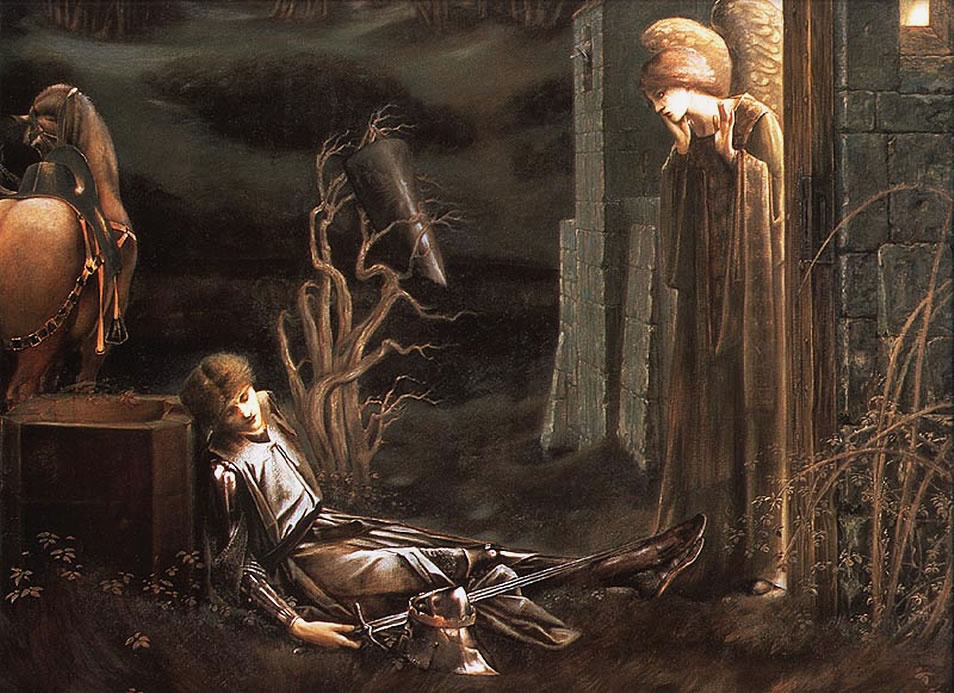
Courtesy: By Edward Burne-Jones – Edward Burne-Jones, 1896, Public Domain, https://commons.wikimedia.org/w/index.php?curid=17441107
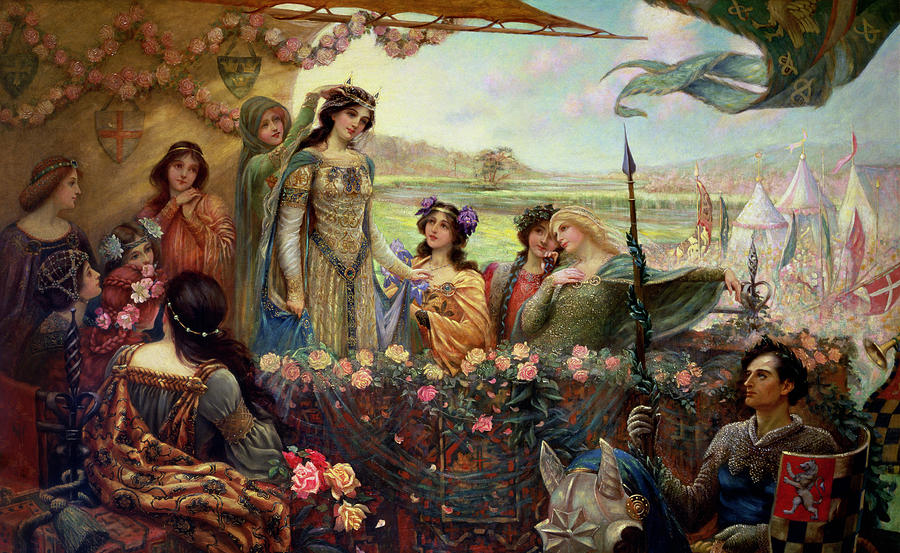
Courtesy: By Herbert James Draper – Herbert James Draper, 1890s, Public Domain, https://commons.wikimedia.org/w/index.php?curid=29858139
Myths reflects archetypal narrative patterns that inform existential phenomena and human nature
From Myths and the Modern World by Karen Armstrong (2005).
“As soon as people became aware of their own mortality they created stories that gave their lives meaning, explained their relationship to the spiritual world, and instructed them on how to live their lives.” (Armstrong, 2005, Introduction From A Cry for Myth by Rollo May (1991):
“As long as our world and society remain… empty of myths, which express beliefs and moral goals, there will be depression… and suicide….In such directionless states as we find ourselves near the end of the twentieth century, it is not surprising that frantic people flock to the new cults, or resurrect the old ones, seeking answers to their anxiety and longing for relief from their guilt or depressions, longing for something to fill the vacuum of their lives.” (Rollo May, 1991, pp. 21- 22).
King Arthur and the Knights of the Round Table. Project Gutenberg eBook. Editor: William Caxton. Produced by Mike Lough, and David Widger
Source: Project Gutenberg: https://www.gutenberg.org/files/1251/1251-h/1251-h.htm
Arthurian Characters
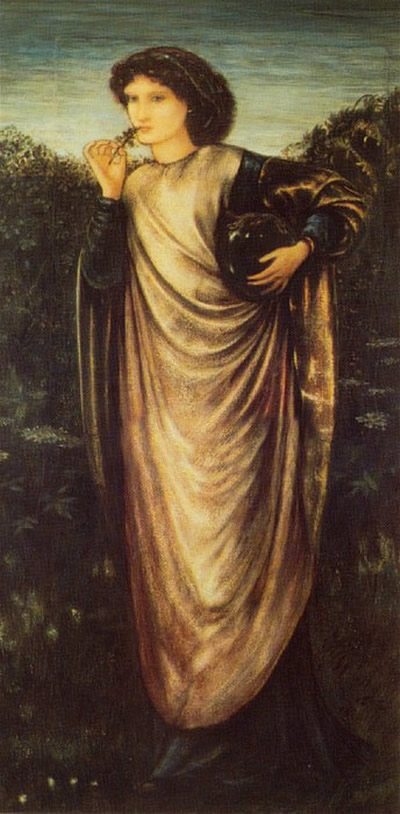
Courtesy: By Edward Burne-Jones – Edward Burne-Jones, 1862, Public Domain, https://commons.wikimedia.org/w/index.php?curid=17463792
In Arthurian legends, Morgan or Morganna Le Faye was the powerful and mysterious enchantress.
https://upload.wikimedia.org/wikipedia/commons/b/bc/Morgan_le_Fay_by_Edward_Burne-Jones.jpg
The Holy Grail
The Holy Grail is often connected to eternal youth, reincarnation, spiritual awakening, and healing. In The Sacred World of the Celts, Nigel Pennick (1997) writes:
“The story of the Holy Grail is among the most powerful and enduring of all Celtic myths. It is a tale of spiritual hope. In the time of King Artyhur (Arthur), after the fall of Rome, the land of Logres (the Welsh name for England) was devastated through human violence, selfishness, and greed. Then, at the feast of King’s Arthur’s knights of the Round Table, the knights saw a vision of the Holy Grail, the cup of regeneration used by Jesus at the Last Supper. They realized that by finding the Holy Grail, they could heal the devastated wasteland of Britain, and restore a just and prosperous land. So the knights set forth on the quest to find it, and many died in the attempt.” (Pennick, 1997, p. 64).
Le Morte d’Arthur( “The Death of Arthur”) evolved from medieval folktales, legends, and myths from French and English sources. Sir Thomas Malory developed the stories of King Arthur, Queen Guinevere, Lancelot, Merlin, and the Knights of the Round Table into popular medieval tales; the Celtic revival of the 19th century highlighted the mystical tales and new artistic renderings by Pre-Raphaelite artists like Edward Burne-Jones and Dante Gabriel Rossetti. For more information about Sir Thomas Malory (1400-1470) please visit the Wikimedia Page.
https://en.wikipedia.org/wiki/Thomas_Malory
King Arthur was a legendary Celtic Briton king; in the medieval histories and romances, King Arthur led the Celtic Britons in battles against Saxon invaders of Britain in the late 5th and early 6th centuries. A blend of folklore, Welsh mythology, and history form the basis for the legends of King Arthur.
For more information about King Arthur and the Knights of the Round Table, please access the sources below.
https://www.gutenberg.org/cache/epub/36462/pg36462-images.html
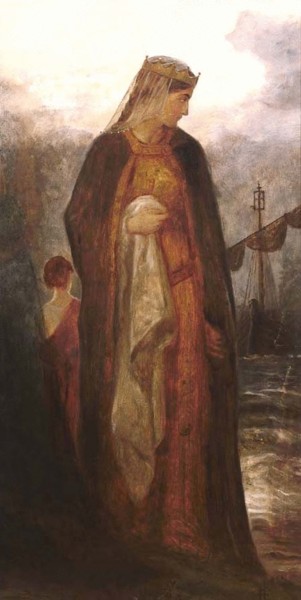
Courtesy: By James Archer (1823-1904), Scotland – The Leicester Galleries loans to The Speed Art Museum, Louisville, Kentucky, Public Domain, https://commons.wikimedia.org/w/index.php?curid=12685563
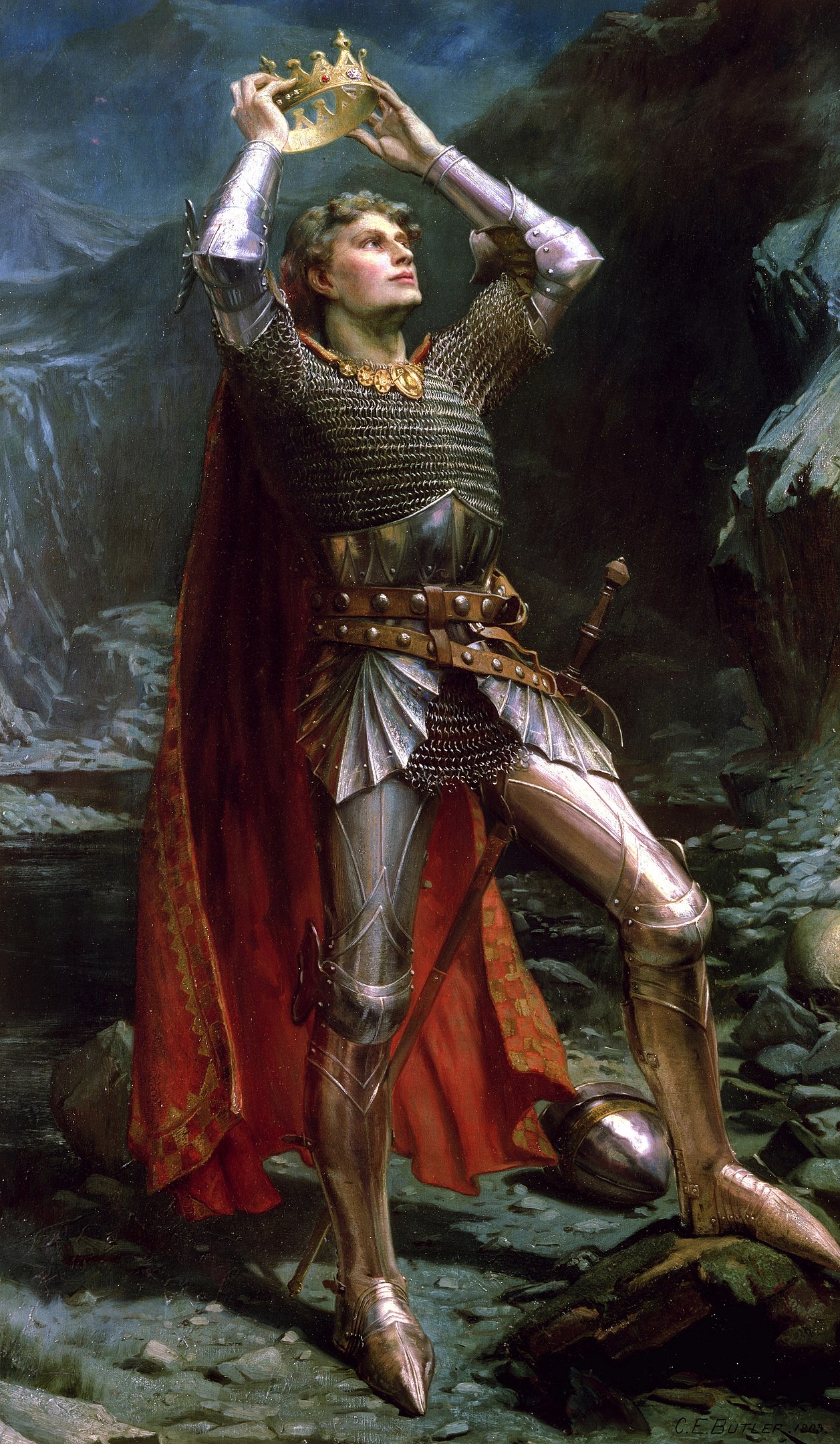
Courtesy: By Charles Ernest Butler – print on canvas, Public Domain, https://commons.wikimedia.org/w/index.php?curid=2770869
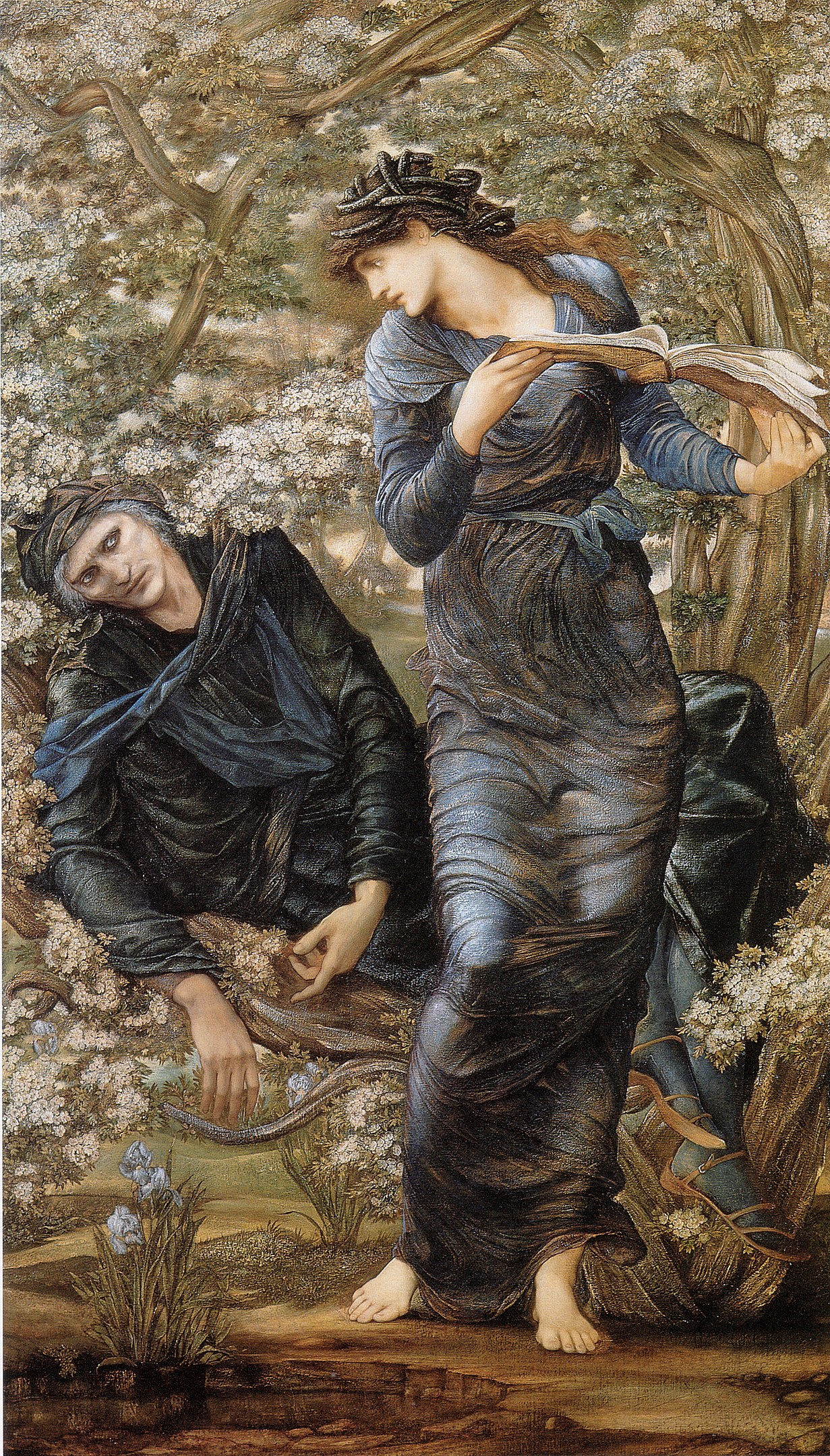
Courtesy: By Edward Burne-Jones – Scanned from Wildman, Stephen: Edward Burne-Jones: Victorian Artist-Dreamer, Metropolitan Museum of Art, 1998, ISBN 0870998595, Public Domain, https://commons.wikimedia.org/w/index.php?curid=2218884
To read about the artist Edward Burne-Jones and his fascination with Arthurian legends and characters please open the link below.
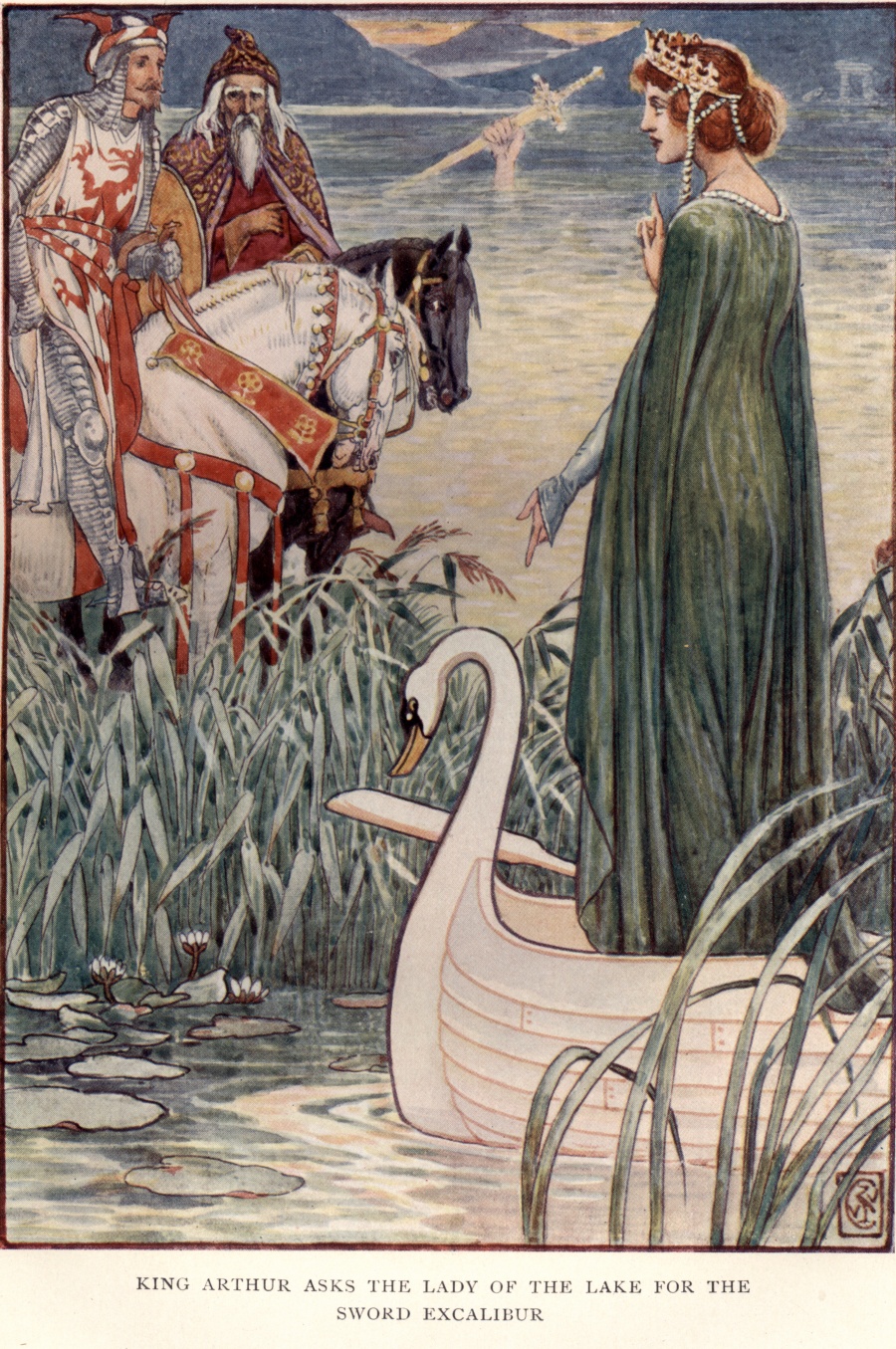
Courtesy: By Walter Crane – Henry Gilbert, King Arthur’s Knights: The Tales Retold for Boys and Girls, Edinburgh and London, T.C. & E.C. Jack, 1911, p. 40., Public Domain, https://commons.wikimedia.org/w/index.php?curid=37202461
Note about the Lady (Wikimedia)
“Who was the mysterious woman who not only gave King Arthur his magical sword Excalibur, but kidnapped Sir Lancelot as a child only later to cure him of his madness? The Lady of the Lake may have been a Celtic goddess in origin, perhaps even related to the Gwagged Annwn, the lake ferries in modern Welsh folklore. According to Ulrich, a fairy raised Sir Lancelot from birth and was the mother of Mabuz, identical to the Celtic god Mabon. There are several “Ladies of the Lake” mentioned throughout Arthurian Legend, with even Morgan Le Fay being named as one of them, in particular as she is one of the maidens on the barg that takes King Arthur to the mystical Isle of Avalon.” (Retrieved July 10, 202 https://upload.wikimedia.org/wikipedia/commons/e/e2/CRANE_King_Arthur_asks_the_lady_of_the_lake_for_the_sword_Excalibur.jpg).
https://kingarthursknights.com/knights-of-the-round-table/sir-galahad/
To read more tales of King Arthur’s Knights by Henry Gilbert (1868-1936) and to view more illustrations by Walter Crane, please access the Project Gutenberg eBook below.
https://www.gutenberg.org/cache/epub/22396/pg22396-images.html
E-text prepared by K. Nordquist, Sigal Alon,
and the Project Gutenberg Online Distributed Proofreading Team
(http://www.pgdp.net)Type your textbox content here.
The Lady of Shalott in Art and Verse
In the Arthurian legends*, the Lady of Shalott was based on the character of Elaine of Astolat; in the tale, she died of unrequited love for Sir Lancelot. For more information please open the link below.
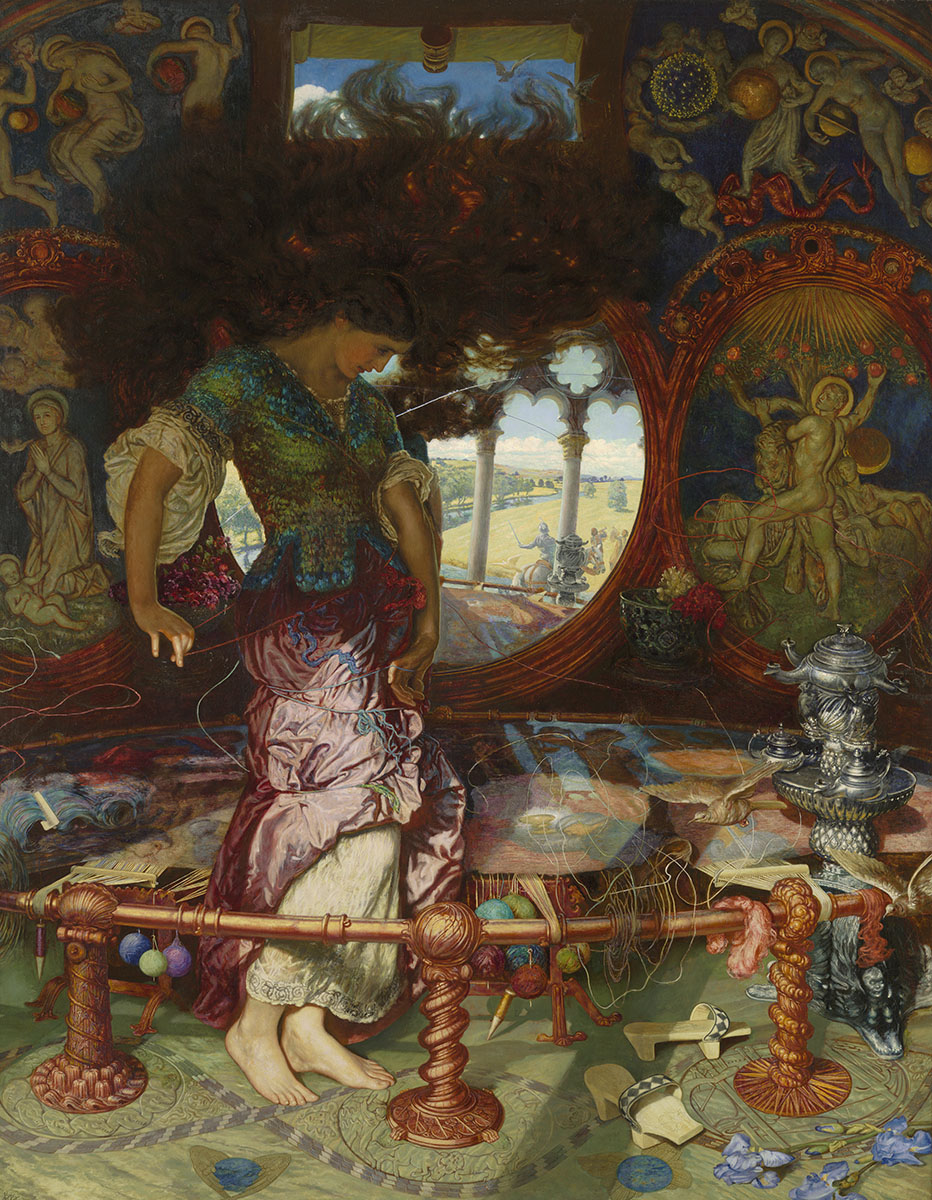
Courtesy: By William Holman Hunt – Unknown source, Public Domain, https://commons.wikimedia.org/w/index.php?curid=897229
https://en.wikipedia.org/wiki/The_Lady_of_Shalott
Manchester Art Gallery Note about the Painting “The Lady of Shalott” by William Holman-Hunt
“A depiction of the chaos which ensues after the Lady of Shalott has looked directly at Sir Launcelot. The Lady stands in her chamber within a circular loom. The partly finished web is disintegrating, entangling the weaver. The Lady stands on the left, dressed in a feather-textured bodice over a cream chemise and pink [hued] skirt. Her long thick auburn hair has been blown high above her head by the turmoil in the room, which has also caused doves to fly from their nests. Her wooden shoes lie discarded on the ground in front of her. There is a floor-standing, silver, six branch candlestick on the right. On the wall behind her is a mirror reflecting the tapestry she is weaving and Sir Launcelot. Two smaller ovals flank the central mirror, the right hand oval containing an image of a bearded man seated with a globe in his hands.” (Retrieved July 29, 2023 https://artuk.org/discover/artworks/the-lady-of-shalott-205251).
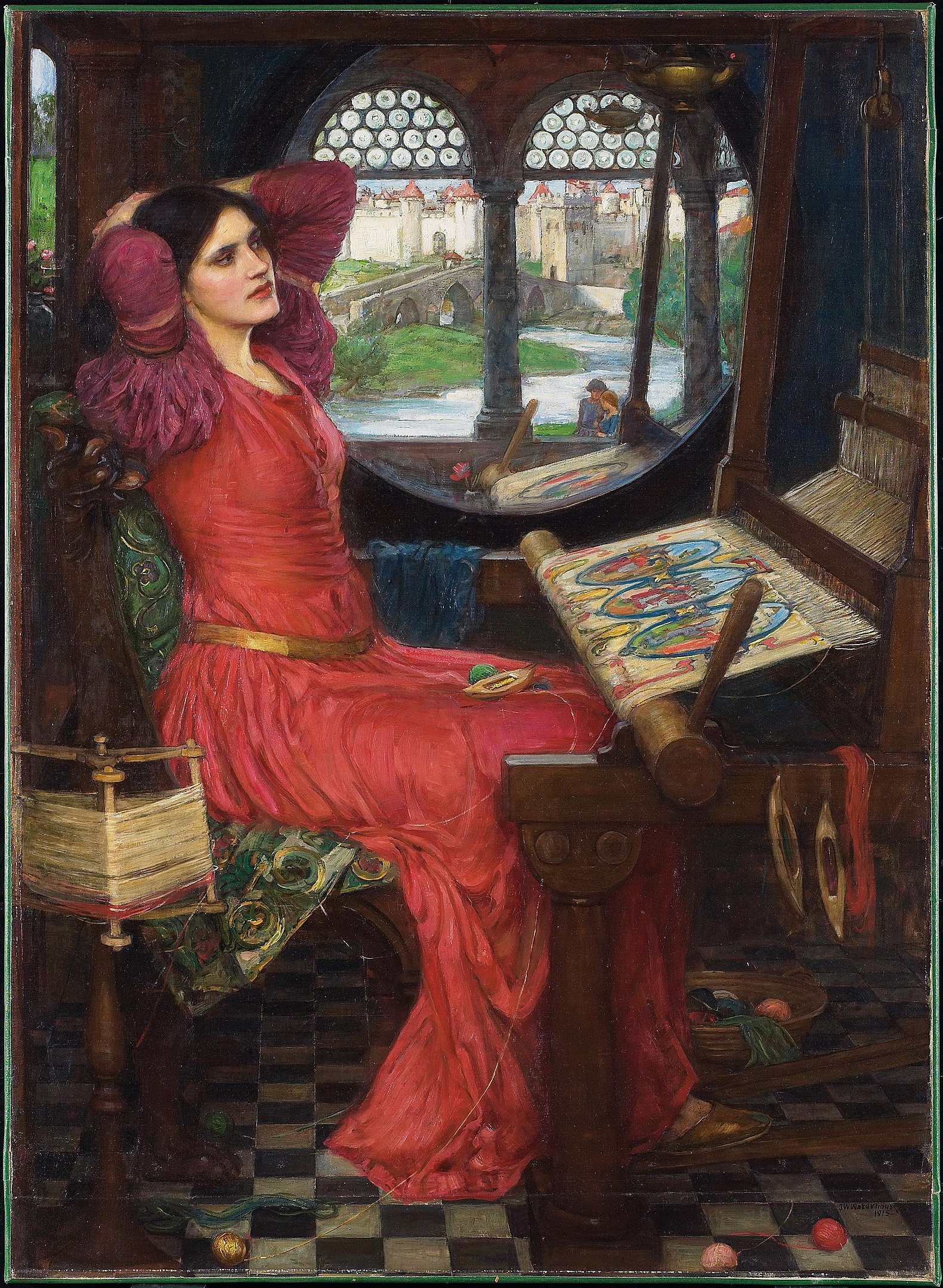
Courtesy: By John William Waterhouse – Unknown source, Public Domain, https://commons.wikimedia.org/w/index.php?curid=1170865
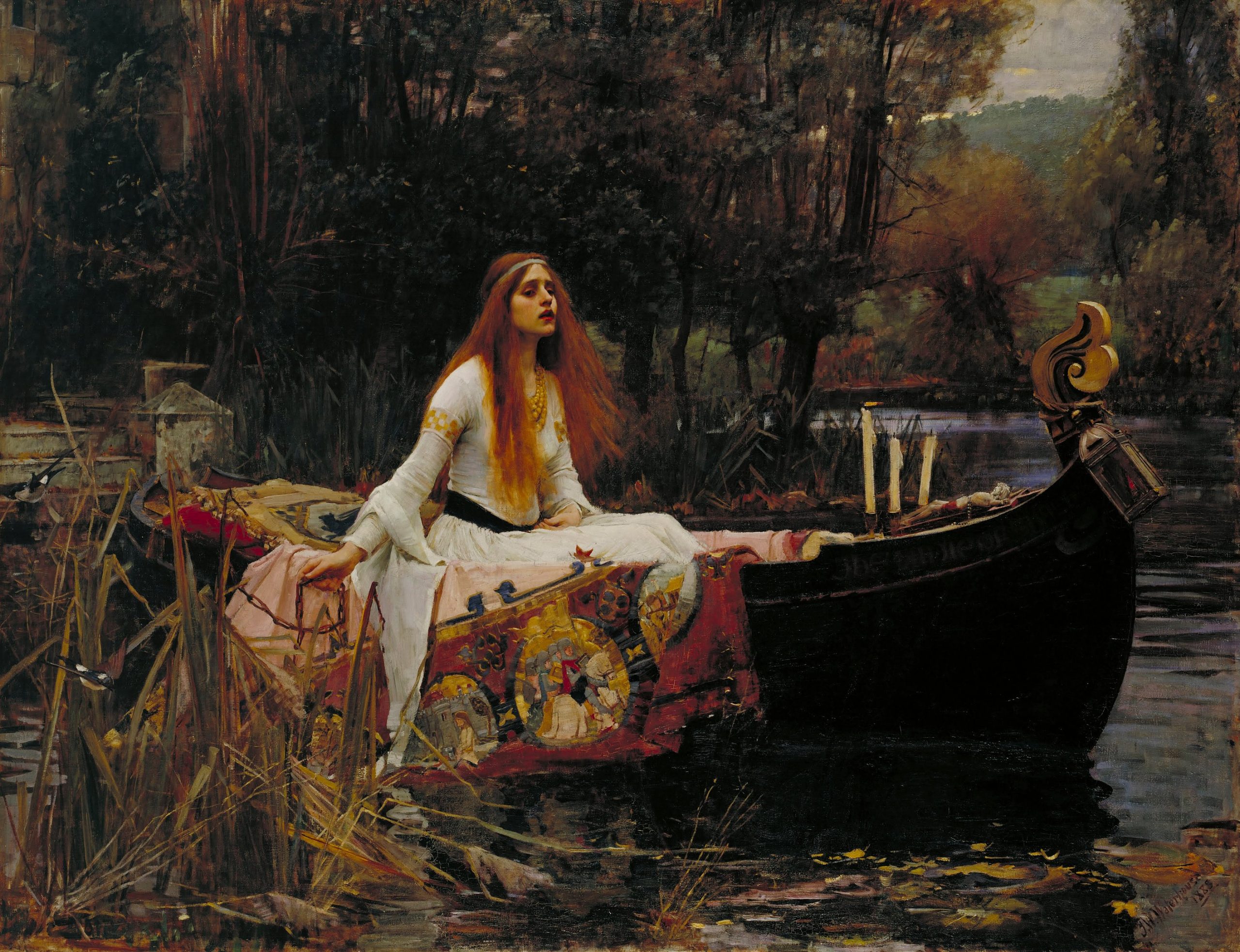
Courtesy: By John William Waterhouse – RQHFwa4u2LTw0g — Google Arts & Culture Tate Images (http://www.tate-images.com/results.asp?image=N01543&wwwflag=3&imagepos=2), Public Domain, https://commons.wikimedia.org/w/index.php?curid=13463656
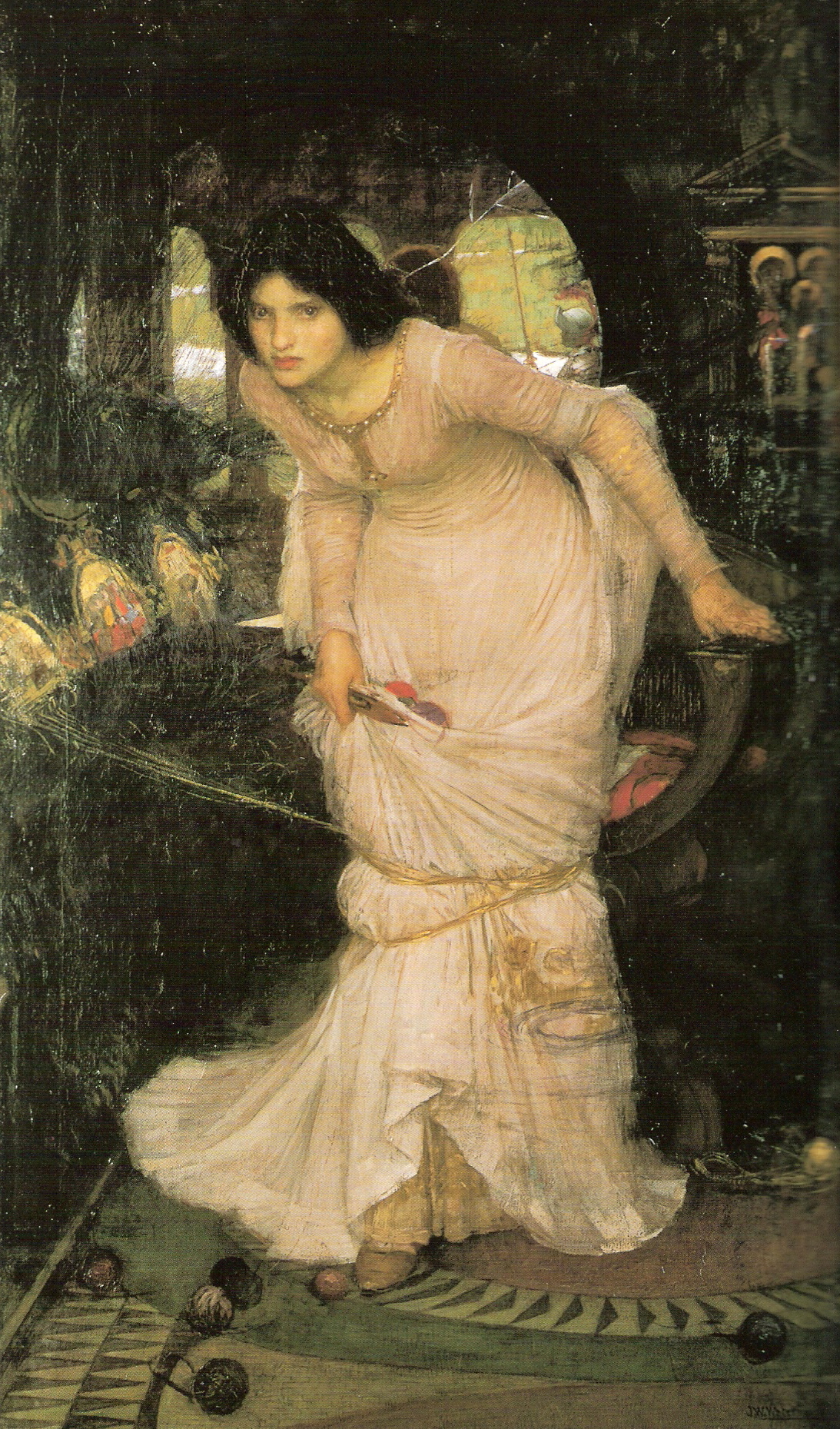
Courtesy: By John William Waterhouse – Unknown source, Public Domain, https://commons.wikimedia.org/w/index.php?curid=1064193
From “The Lady of Shalott” by Alfred Lord Tennyson“She left the web, she left the loom, She made three paces thro’ the room, She saw the water-lily bloom, She saw the helmet and the plume, She look’d down to Camelot. Out flew the web and floated wide; The mirror crack’d from side to side; “The curse is come upon me,” cried the Lady of Shalot”
The Lady of Shalott by Alfred Lord Tennyson (1809-1892)
Part I
On either side the river lie
Long fields of barley and of rye,
That clothe the wold and meet the sky;
And thro’ the field the road runs by
To many-tower’d Camelot;
And up and down the people go,
Gazing where the lilies blow
Round an island there below,
The island of Shalott.
Willows whiten, aspens quiver,
Little breezes dusk and shiver
Thro’ the wave that runs for ever
By the island in the river
Flowing down to Camelot.
Four gray walls, and four gray towers,
Overlook a space of flowers,
And the silent isle imbowers
The Lady of Shalott.
By the margin, willow-veil’d
Slide the heavy barges trail’d
By slow horses; and unhail’d
The shallop flitteth silken-sail’d
Skimming down to Camelot:
But who hath seen her wave her hand?
Or at the casement seen her stand?
Or is she known in all the land,
The Lady of Shalott?
Only reapers, reaping early
In among the bearded barley,
Hear a song that echoes cheerly
From the river winding clearly,
Down to tower’d Camelot:
And by the moon the reaper weary,
Piling sheaves in uplands airy,
Listening, whispers “’Tis the fairy
Lady of Shalott”.
Part II
There she weaves by night and day
A magic web with colours gay.
She has heard a whisper say,
A curse is on her if she stay
To look down to Camelot.
She knows not what the curse may be,
And so she weaveth steadily,
And little other care hath she,
The Lady of Shalott.
And moving thro’ a mirror clear
That hangs before her all the year,
Shadows of the world appear.
There she sees the highway near
Winding down to Camelot:
There the river eddy whirls,
And there the surly village-churls,
And the red cloaks of market girls,
Pass onward from Shalott.
Sometimes a troop of damsels glad,
An abbot on an ambling pad,
Sometimes a curly shepherd-lad,
Or long-hair’d page in crimson clad,
Goes by to tower’d Camelot;
And sometimes thro’ the mirror blue
The knights come riding two and two:
She hath no loyal knight and true,
The Lady of Shalott.
But in her web she still delights
To weave the mirror’s magic sights,
For often thro’ the silent nights
A funeral, with plumes and lights,
And music, went to Camelot:
Or when the moon was overhead,
Came two young lovers lately wed;
“I am half-sick of shadows,” said
The Lady of Shalott.
Part III
A bow-shot from her bower-eaves,
He rode between the barley sheaves,
The sun came dazzling thro’ the leaves,
And flamed upon the brazen greaves
Of bold Sir Lancelot.
A redcross knight for ever kneel’d
To a lady in his shield,
That sparkled on the yellow field,
Beside remote Shalott.
The gemmy bridle glitter’d free,
Like to some branch of stars we see
Hung in the golden Galaxy.
The bridle bells rang merrily
As he rode down to] Camelot:
And from his blazon’d baldric slung
A mighty silver bugle hung,
And as he rode his armour rung,
Beside remote Shalott.
All in the blue unclouded weather
Thick-jewell’d shone the saddle-leather,
The helmet and the helmet-feather
Burn’d like one burning flame together,
As he rode down to Camelot.
As often thro’ the purple night,
Below the starry clusters bright,
Some bearded meteor, trailing light,
Moves over still Shalott.
His broad clear brow in sunlight glow’d;
On burnish’d hooves his war-horse trode;
From underneath his helmet flow’d
His coal-black curls as on he rode,
As he rode down to Camelot.
From the bank and from the river
He flashed into the crystal mirror,
“Tirra lirra,” by the river
Sang Sir Lancelot.
She left the web, she left the loom;
She made three paces thro’ the room,
She saw the water-lily bloom,
She saw the helmet and the plume,
She look’d down to Camelot.
Out flew the web and floated wide;
The mirror crack’d from side to side;
“The curse is come upon me,” cried
The Lady of Shalott.
Part IV
In the stormy east-wind straining,
The pale yellow woods were waning,
The broad stream in his banks complaining,
Heavily the low sky raining
Over tower’d Camelot;
Down she came and found a boat
Beneath a willow left afloat,
And round about the prow she wrote
The Lady of Shalott.]
And down the river’s dim expanse—
Like some bold seër in a trance,
Seeing all his own mischance—
With a glassy countenance
Did she look to Camelot.
And at the closing of the day
She loosed the chain, and down she lay;
The broad stream bore her far away,
The Lady of Shalott.
Lying, robed in snowy white
That loosely flew to left and right—
The leaves upon her falling light—
Thro’ the noises of the night
She floated down to Camelot;
And as the boat-head wound along
The willowy hills and fields among,
They heard her singing her last song,
The Lady of Shalott.
Heard a carol, mournful, holy,
Chanted loudly, chanted lowly,
Till her blood was frozen slowly
And her eyes were darken’d wholly,
Turn’d to tower’d Camelot;
For ere she reach’d upon the tide
The first house by the water-side,
Singing in her song she died,
The Lady of Shalott.
Under tower and balcony,
By garden-wall and gallery,
A gleaming shape she floated by,
Dead-pale between the houses high,
Silent into Camelot.
Out upon the wharfs they came,
Knight and burgher, lord and dame,
And round the prow they read her name,
The Lady of Shalott
Who is this? and what is here?
And in the lighted palace near
Died the sound of royal cheer;
And they cross’d themselves for fear,
All the knights at Camelot:
But Lancelot mused a little space;
He said, “She has a lovely face;
God in his mercy lend her grace,
The Lady of Shalott”
(Retrieved July 27, 2023 Project Gutenberg eBook https://www.gutenberg.org/files/8601/8601-h/8601-h.htm#chap28)
Produced by Jonathan Ingram, Clytie Siddall, Charles Franks, and the Online Distributed Proofreading Team
“The Lady of Shalott” by Alfred Lord Tennyson (1832) Poetry Foundation
https://www.poetryfoundation.org/poems/45359/the-lady-of-shalott-1832
Additional Links:
Essay behind the painting of The Lady of Shalott by William Waterhouse
https://victorianweb.org/painting/prb/newman12.html#jww
Essay by Ashlet Pratt: Interpretation of the Lady of Shalott.
https://www.lycoming.edu/schemata/documents/art349w_pratt.pdf
A Poem and a Painting: The Lady of Shalott
https://britlitsurvey2.wordpress.com/2014/05/02/the-lady-of-shalott-a-poem-and-a-painting/
To read Alfred Lord Tennyson’s Morte d’Arthur (The Death of King Arthur), please open the Project Gutenberg eBook:
https://www.gutenberg.org/files/8601/8601-h/8601-h.htm#chap52
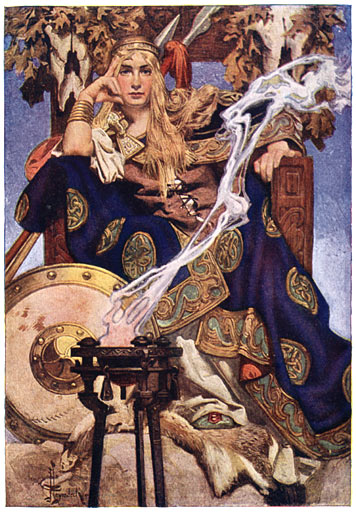
Courtesy: By Joseph Christian Leyendecker (1874 – 1951) – T. W. Rolleston, Myths and Legends of the Celtic Race, Public Domain, https://commons.wikimedia.org/w/index.php?curid=3485557
Queen Maev was a Celtic warrior queen known for her strong-will and cunning. In Celtic mythology she is also known to be a fertility and earth goddess. She may have been the inspiration for William Shakespeare’s famous “Queen Mab” speech in Romeo and Juliet.
For more information please open the Wikimedia Link below.
To learn more about Celtic tales, please access the complete Project Gutenberg eBook text by T. W. Rolleston.
https://www.gutenberg.org/files/34081/34081-h/34081-h.html
British edition published by Constable and Company Limited, London
First published 1911 by George G. Harrap & Co., London.

